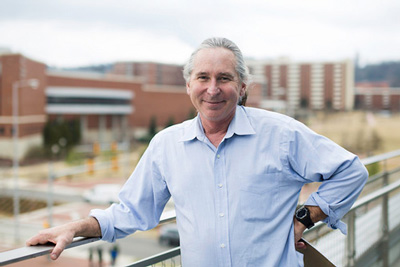By Christina Crowe
Andrew Pollard, Ph.D., a longtime professor in the UAB Biomedical Engineering, has announced his retirement effective June 1, 2021, after 25 years with the department.
 Pollard, who calls himself a “working-man scientist,” says he has always enjoyed his time in time in the lab, and plans to continue working in his research lab conducting collaborative research on cardiac conduction with Jianyi Zhang, M.D., Ph.D., T. Michael and Gillian Goodrich Endowed Chair of Engineering Leadership, UAB Biomedical Engineering.
Pollard, who calls himself a “working-man scientist,” says he has always enjoyed his time in time in the lab, and plans to continue working in his research lab conducting collaborative research on cardiac conduction with Jianyi Zhang, M.D., Ph.D., T. Michael and Gillian Goodrich Endowed Chair of Engineering Leadership, UAB Biomedical Engineering.
“We are very grateful to Dr. Pollard for the work he has done in our department, both in education and research,” says Zhang. “He excels in both areas and served as both a scientific collaborator and as a mentor to many. His impact on the study of cardia conduction has been immense, as has his leadership as a teacher.”
Pollard received his doctor of philosophy in Biomedical Engineering from Duke University; in fact all of his college and graduate degrees came from the same institution.
“I grew up in a suburb of Phoenix, Arizona, and made jokes about applying early to get in to Duke—which I did,” he says. “I ended up staying nine years.”
Colleagues and friends know Pollard as a serious researcher, teacher and mentor, who in his off time is very active in hobbies outdoors. This love of nature and sports influenced his choice of jobs and continues to shape his life as he moves into retirement.
As an undergraduate, Pollard worked with a faculty advisor who did computer modeling, and piqued his interest in that area of biomedical engineering. That professor, Roger Barr, still works on faculty at Duke and has been a collaborator on several NIH-sponsored grants with Pollard.
After completing his Ph.D. in Biomedical Engineering at Duke, Pollard headed from the east coast out west to Utah, where he took a Research Associate position in the Nora Eccles Harrison Cardiovascular Research and Training Institute at the University of Utah, in Salt Lake City.
“I was always intrigued by Utah because I was a skier, and so I ended up taking a postdoctoral position out there,” Pollard says. “It turned out to be an incredible place, both for skiing and for my career.”
Pollard worked with mentors Mary Jo Burgess, M.D., Professor Emeritus, School of Medicine and Kenneth Spitzer, Ph.D., Professor of internal Medicine and Director of the Nora Eccles Harrison Cardiovascular Research and Training Institute, and was able to conduct modeling and participate in open chest heart surgery on canines.
From there, Pollard sought a tenure-track position and secured an assistant professorship with the Department of Biomedical Engineering at Tulane University, where, during his four-year tenure there, he secured National Science Foundation and NIH grants. After four years, in 1996, he was offered an associate professorship in UAB’s growing Department of Biomedical Engineering, where three new faculty slots had been created. Two of his former colleagues from Duke University joined him.
“It just worked out really well, with great animal resources in the lab—it was a really heady time those first five years,” he recalls.
At UAB, Pollard was able to build on his prior relationships to bring students from Tulane, and maintain research collaborations from his time at Utah. His lab moved into a second phase as the PI on one project from a large program project grant. At the same time, BME’s undergraduate program was getting started, and Pollard has taught many of its courses throughout his career. In 2004 Pollard secured an R21 to study novel methods for cardiac micro-impedance measurements, which expanded into an R01 and ran through 2016.
During those years, he took on more teaching and service responsibilities. Pollard served as Graduate program director for the department from 2001 to 2005. The department had a new chair, Zhang, and Pollard began working on research with him, which features electrode systems that allow interrogation of preparations to assess whether electrical gap junctions are forming as the tissue patches grow in culture. He plans to continue to work on those projects with Zhang following retirement.
“Over the years it has been great to work on projects with other faculty,” he says. “I was really pleased to learn I will still be able to do so.”
Pollard credits his mentors for helping him achieve success in his career, and as a mentor himself.
“The turtle on top of the post didn’t get there by itself,” he says. He has won numerous teaching awards, including the Graduate Dean’s Award for Excellence in Mentorship in 2013, and the President’s Award for Teaching in 2009.
Pollard says some of his mentors as a young faculty member taught him how faculty positions work, teaching versus research tracks, and other issues that arise in academic careers. He credits William Smith, Ph.D., Professor Emeritus at UAB who retired in 2007, with helping him flesh out ideas. “He was well-schooled in getting NIH and other grants and was valuable in teaching how study sections work, and how to navigate those dynamics,” he says. “He gave me a blueprint of things to avoid.”
In retirement, Pollard has plans to visit his adult daughter and son who live in Boston and Montana, respectively, with his wife, who is a college counselor at The Altamont School. Other plans include windsurfing, a sport he picked up during his time at Duke, where he would surf the Outer Banks. He is also looking forward to continuing the electrical characterization studies with Zhang.